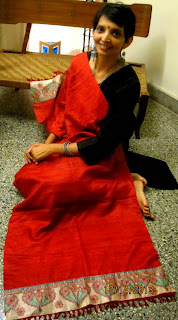Beautiful imprinted designs have been found on scraps of
cloth in the ruins of Mohenjo Daro which was an ancient city of the Indus
Valley Civilization. This is evidence that block printing in India was practiced as
long as 3000 B.C. This labour intensive, painstaking process is still practiced
in 21st century by many artisans which makes India one of the
largest manufacturers of block printed fabric. One of the main forms of block
printing include the Dabu & Bagru Block printing of Rajasthan.
Amidst the dry barren desert land are places abundant of
colour, heritage and culture. 30 kms south-west of Jaipur and along the Ajmer
highway is a small village called Bagru. The residents of Bagru are the Chippa
community who have been into the block printing art form for about 350 years. Also
60 kms from Chitthorgarh there is a small village named Akola where the first
forms of Dabu printing was practiced. Dabu is a form of mud resistant block
printing which is practiced mainly in Rajasthan. The uniqueness of Dabu print
lies in its sublime quality and appearance. Also the printing involves lots of
natural dyes and pastes made from vegetables which makes it environmentally
friendly. The process of making these printed fabrics includes a lot of manual labour and sheer hard
work. It begins by mixing a special clay paste called “dhabu”. A particular
design is then sketched on the cloth and is covered with clay and wooden blocks
after which saw dust is sprinkled. Once dried the cloth is dyed with the chosen
colour. After dyeing the cloth can again be dyed with a lighter colour to give
patterns. The process is so lengthy and labour intensive that the end result is
worth it.
Bagru is a named derived from “Bagora’” which is the name of
a island where the city was built originally. It’s famous for palm fans and
fadat patterns. Bagru block printing are usually practiced by the local women
folk. Bagru prints can be characterized by their rich colour prints and
patterns. Using indigenous methods of dyeing and printing beautiful colours
like indigo blue, bright yellow, alizarin etc. are imparted to the cotton
fabric. The three main colours in Bagru include black, maroon and red. Patterns
involve geometric patterns combined with flora, animal and bird forms.
Synthetic dyes have now replaced some of the natural dyes but the process of
making the final products continues to be the same. Some of the motifs and
styles too have been adapted with the changing trends. New bases like fabrics,
motifs and layouts are now experimented instead of cotton and silk as
traditional bases.
With many institutes such as the National Institute of Hand
printed Textiles, NIFT, NID and other boutique owners and exporters, this
traditional form of block printing is being given encouragement. With changes
in traditional market the chippa community has successfully adapted to its
customer’s needs..
This season we bring you Dabu and Bagru Hand block printed
Chanderi Cotton silk and Soft mul mul Dupattas.
- Contributed by Antorik Roy for Banna Creations !








